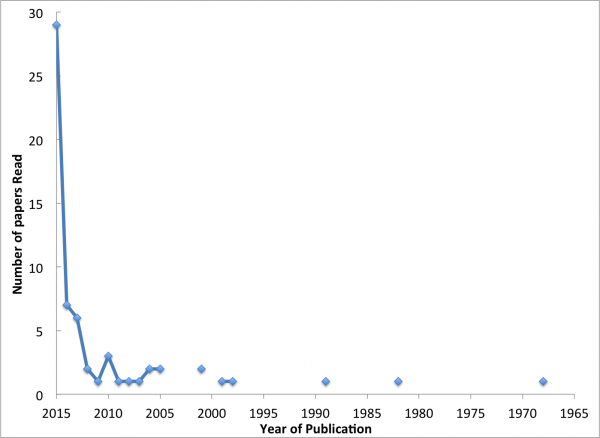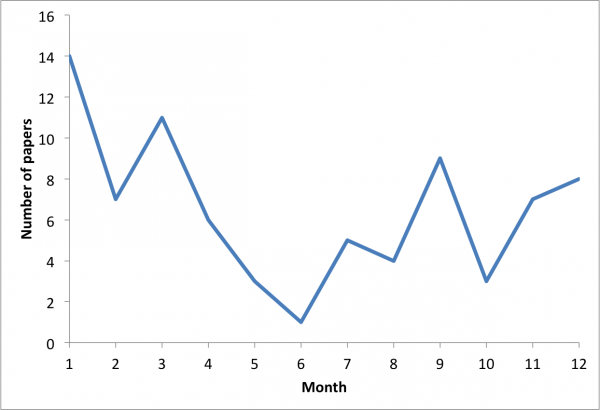![]() For the last year, I’ve tweeted every paper I read. Inspired by Jacquelyn Gill’s resolution and hashtag #365papers, I wanted to spur myself to read more and to see how well I did. I never thought I’d read 365 papers, but I really didn’t have a sense of exactly how much I was reading, other than “far fewer than I download and put in my ‘to read’ folder.” Now, as the year draws to a close, I know how many papers I have read (78) and quite a bit more about my reading patterns. Plus, I know lots more cool science than I did this time last year.
For the last year, I’ve tweeted every paper I read. Inspired by Jacquelyn Gill’s resolution and hashtag #365papers, I wanted to spur myself to read more and to see how well I did. I never thought I’d read 365 papers, but I really didn’t have a sense of exactly how much I was reading, other than “far fewer than I download and put in my ‘to read’ folder.” Now, as the year draws to a close, I know how many papers I have read (78) and quite a bit more about my reading patterns. Plus, I know lots more cool science than I did this time last year.
In addition to tweeting all of my papers, I compiled a storify in order to keep track of my reading. In addition to letting me check what number paper I was on, I also found myself using the storify as a way to quickly recall the title of a paper I’d read. And today, I decided to data mine the tweets and quantify my 2015 reading.
What types of things did I read?
56 journal articles
4 journal articles that I co-authored that appeared in press in 2015
14 grant proposals as a reviewer
3 manuscripts as a reviewer
1 government technical report “cover to cover”
uncounted student thesis drafts and homework assignments
a gazillion really informative blog posts and on-line articles from which I learned a lot of science
I read and reviewed a lot more proposals this year than ever before. I also reviewed a lot fewer manuscripts than I had the past several years (in part because of all the proposals, but also because I declined reviews while on maternity leave). While I absolutely learn a ton of science reviewing proposals, I want to make sure that I don’t forsake reading papers that are directly useful (and citable) in my own work because I’m spending so much time on proposals. Something to watch for next year!
How did I get access to things I read?
- Of the 61 journal articles, 15 (24%) were available open access on the publisher’s website, either because the whole journal is open access (e.g., Plos One, HESS), older articles are now available open access (e.g., AGU journals older than 2 years), or the authors paid for open access.
- Many more articles are available via ResearchGate, author websites, university archives, or various uploads, so the actual proportion of articles I had to use my university access to get was lower.
- Even with good university access, there were articles I wanted to read that I had a hard time getting. And there are articles I haven’t been able to read that I really wish I could.
- A lot of my reading was done on my tablet while holding a baby, and I found that I gravitated towards articles that were OA because I didn’t want to deal with the hassle of figuring out how to get the VPN working and download a PDF. In a somewhat surprising development, I found that I really appreciated that journals that had nice HTML versions of they articles available OA because they were more screen friendly than the PDFs I usually read.
Who wrote the things I read?
- Inspired by a discussion with Jacquelyn Gill and Meghan Duffy, I quickly counted the proportion of woman first authors among the journal articles I read, and I was pleasantly surprised. Of the 61 articles, 20 had woman first authors (33%).
33% is actually better than the 20% of US earth science faculty positions filled by women, though lower than the 40+% of geoscience PhDs awarded to women. - However, the number of unique woman first authors is somewhat lower (as is the number of man first authors).
- And, my own papers turn out to bias the statistics. Of the four papers, I’m an author on this year, three have woman first authors (all different!). Removing my papers from the list, we find 30% of the papers I read had woman first authors.
When were the papers written?

My 2015 article consumption has a decidedly non-normal distribution, and this is probably perfectly “normal” for someone who has been reading the literature for several years.
I love this result, because it’s pretty much what I think “keeping up with the literature” should look like for someone who has been working in the same field for at least a few years. I’m reading a lot of new papers that come across my radar by email alerts. I’m finding plenty of papers out in the past few years that slipped past my detectors at first but are showing up in the citations of new papers. And I’m revisiting some old favorites and classics that have stood the test of time. My paper age distribution would have looked much different in graduate school or when I first started working in urban hydrology, as I frantically tried to “catch up” with the state of the science.
median publication date for things I read this year: 2014
weighted average publication date: 2010
What were the top journals I read this year?
Journal of Hydrology (7)
Water Resources Research (5)
Environmental Science and Technology (3)
Geophysical Research Letters (3) (even though we don’t have an institutional subscription and I can’t get new papers)
Hydrological Processes (3)
Journal of Environmental Engineering (3) (even though I have difficulty accessing new papers from ASCE journals)
Plos One (3) (yay open access)
In total, I read from 38 journals. I’m impressed by that.
When did I read and review?
I read the most papers in January. I also gave birth in early January. Newborns don’t do very much, but they like to be held. In this case, correlation is evidence of causation. Note that my reading rate declines as the baby becomes more active. It’s lowest in June, as it should be, since we were on vacation for several weeks. I’m mostly troubled by the October slump, for which I have no excuses other than mid-semester busy-ness. Even with classes and grants and conferences and grading, I’d like to feed my brain a bit better throughout the semester.
Any favorite papers?
There are so many good papers out there, but if I had to pick just one to rave about it, it would definitely be:
Lundquist, J. D., N. E. Wayand, A. Massmann, M. P. Clark, F. Lott, and N. C. Cristea (2015), Diagnosis of insidious data disasters, Water Resour. Res., 51, 3815–3827, doi:10.1002/2014WR016585.
It’s even open access, and so, so good for anyone who takes in and makes use of field data.




Comments (3)
Links (1)
-
Pingback: A recap of my year in #365papers | Dynamic Ecology